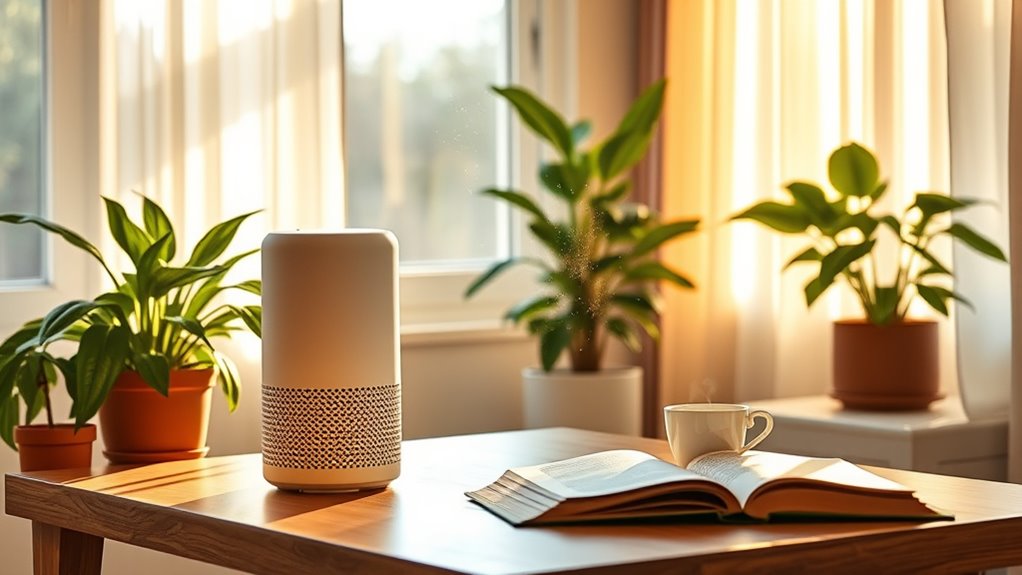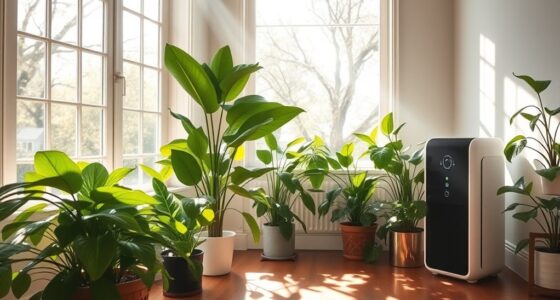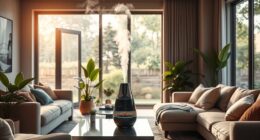Choosing the perfect air purifier starts with understanding your specific air quality needs. Look for models with HEPA filters to capture allergens and consider CADR ratings to guarantee effective pollutant removal based on your room size. Pay attention to important features like WiFi connectivity and air-quality sensors for added convenience. Proper placement and regular maintenance will maximize efficiency. Stick around to discover more tips and tricks to help you make the best choice for your home environment.
Key Takeaways
- Identify specific pollutants in your environment to select an air purifier with the right filter type, such as HEPA for allergens or activated carbon for odors.
- Check the CADR ratings to ensure the air purifier can effectively clean the air in your specific room size; aim for higher ratings for better performance.
- Maintain proper placement by keeping the purifier in an open area with adequate space around it for optimal airflow and circulation.
- Regularly replace filters according to manufacturer recommendations to maintain efficiency; monitor service indicators for timely maintenance reminders.
- Consider smart features like air-quality sensors and WiFi connectivity for enhanced control and convenience in managing indoor air quality.
Understanding Your Air Quality Needs
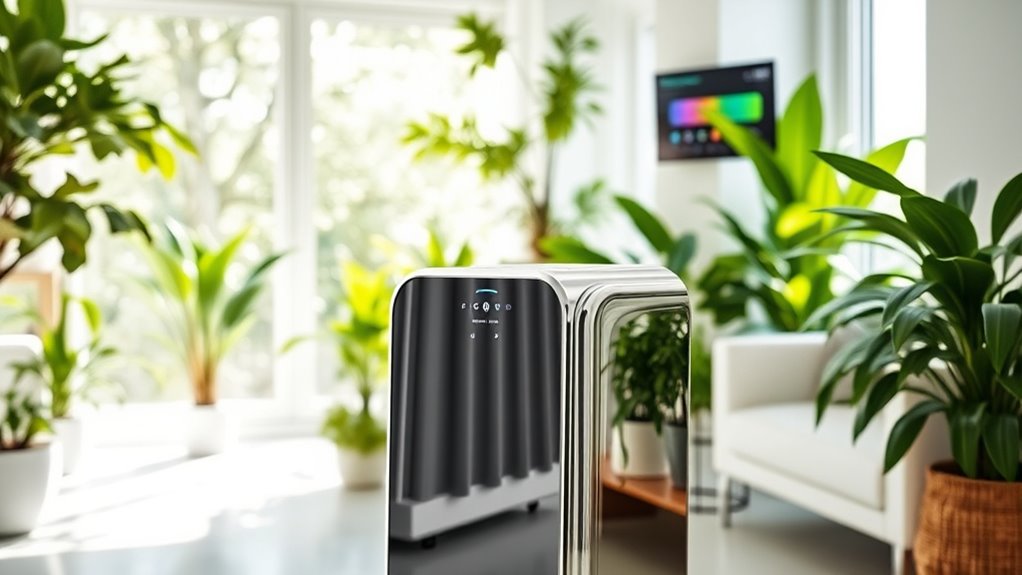
How well do you understand your indoor air quality needs? To make the right choice in air purifiers, start by identifying the specific pollutants in your environment.
Understanding your indoor air quality needs is essential for selecting the right air purifier to combat specific pollutants.
If you’re dealing with dust, pollen, pet dander, or smoke, you’ll want a purifier equipped with HEPA filters, which can capture 99.97% of particles down to 0.3 micrometers, effectively reducing allergens. Regular use of suitable air purifiers can lead to improved respiratory health, alleviating symptoms of asthma and allergies. Certain models, like the Winix 5500-2, utilize PlasmaWave technology for enhanced allergen neutralization, making them an excellent choice for comprehensive air purification. Regular maintenance and cleaning of your air purifier can significantly enhance its effectiveness and lifespan, similar to how proper storage is essential for maintaining airless paint sprayers.
For those in wildfire-prone areas, look for models that specifically target smoke particulates.
Also, consider the size of your room; verify the air purifier’s CADR rating meets the recommended levels for effective air cleaning.
Regularly monitor your indoor air quality with sensors so you can adjust your purifier settings or placement for peak performance. Additionally, ensure to choose a model with smart capabilities to enhance convenience and control over your air quality.
The Importance of CADR Ratings

When choosing an air purifier, understanding CADR ratings is essential for ensuring clean air in your space. These ratings help you match the purifier’s performance to your room size, so you get the ideal levels of air quality for your needs. Additionally, just as security systems deter potential burglars, effective air purifiers can also enhance the safety and comfort of your home environment. A higher CADR rating indicates better pollutant reduction, ensuring that harmful airborne particles are effectively filtered from your indoor air. For optimal performance, consider air purifiers that offer high CADR ratings, as they are designed to efficiently clean larger spaces. Regular filter maintenance is also crucial for sustaining the purifier’s efficacy over time. Furthermore, selecting a model with HEPA filters ensures that even the smallest particles are captured, maximizing the health benefits of cleaner air.
Understanding CADR Ratings
Understanding CADR ratings is essential for selecting the right air purifier for your needs.
CADR, or Clean Air Delivery Rate, measures how effectively an air purifier removes pollutants like dust, pollen, and smoke.
Here are three key points to take into account:
- A CADR of at least 150 CFM is ideal for small rooms under 200 sq. ft.
- Medium rooms up to 400 sq. ft. need around 260 CFM for maximum airflow.
- Larger spaces over 400 sq. ft. require CADR ratings exceeding 300 CFM for effective cleaning. Additionally, selecting a model with high Clean Air Delivery Rates can significantly enhance your air quality improvement experience. Furthermore, modern heat pumps improve indoor air quality by filtering and circulating air, which can complement the benefits of using an air purifier. It’s also worth noting that factors such as monitoring options can influence the overall effectiveness of air purification in specific environments. Regular filter cleaning and replacement can further optimize the performance of your air purifier, ensuring it operates efficiently for better air quality. Moreover, integrating energy-efficient systems like heat pumps can contribute to overall indoor comfort while promoting sustainability.
Importance of Room Size
Room size plays an essential role in the effectiveness of an air purifier.
When you’re shopping, refer to the Clean Air Delivery Rate (CADR) ratings that indicate how well an air purifier can clean the air of specific pollutants. Factors influencing currency values can be analogous to understanding how different air purifiers perform in various environments. Additionally, choosing a model with multi-surface capability can enhance its versatility in different room types. Toys designed for young children, such as balance bikes for kids, promote safe exploration and active play, paralleling the importance of choosing the right air purifier for your environment. It’s also crucial to consider overall costs of leasing a car to understand the financial commitment involved in purchasing an air purifier.
For small rooms under 200 sq. ft., look for a CADR of at least 150 CFM.
For medium spaces, aim for around 260 CFM, and for large rooms exceeding 400 sq. ft., you’ll need a CADR over 300 CFM.
This buying guide guarantees you choose an air purifier that matches your room size for effective air cleaning.
Avoid misleading marketing claims; always verify CADR ratings through trusted sources like the AHAM directory to make informed decisions. Additionally, researching company performance can help you identify reputable air purifier brands that prioritize effective filtration technology.
Ideal CADR Levels
Choosing the right air purifier hinges on understanding CADR ratings, which indicate how effectively a unit removes specific pollutants from the air.
To guarantee you pick the perfect model, consider these key points:
- For small rooms under 200 square feet, aim for a CADR of at least 150 CFM.
- Medium-sized rooms (up to 400 square feet) require a CADR of approximately 260 CFM for effective air purification.
- Larger spaces exceeding 400 square feet should utilize air purifiers with CADR scores over 300 CFM. Additionally, selecting a model that integrates with smart home devices can enhance your overall air quality management.
Types of Air Purifiers Explained

When it comes to selecting an air purifier, knowing the different types available can help you make an informed decision.
Mechanical filters, like HEPA filters, capture 99.97% of particulate matter as small as 0.3 micrometers, effectively removing dust, pollen, and pet dander.
Activated carbon filters absorb odors and harmful gases, but remember to replace them every three months for best results.
Ozone generators produce ozone to purify air, but they’re not recommended due to health risks and ineffectiveness.
UVGI purifiers aim to kill pathogens, though their effectiveness can vary and may create harmful byproducts.
Consider these options carefully to find the right air purifier for your needs.
Key Features to Look For
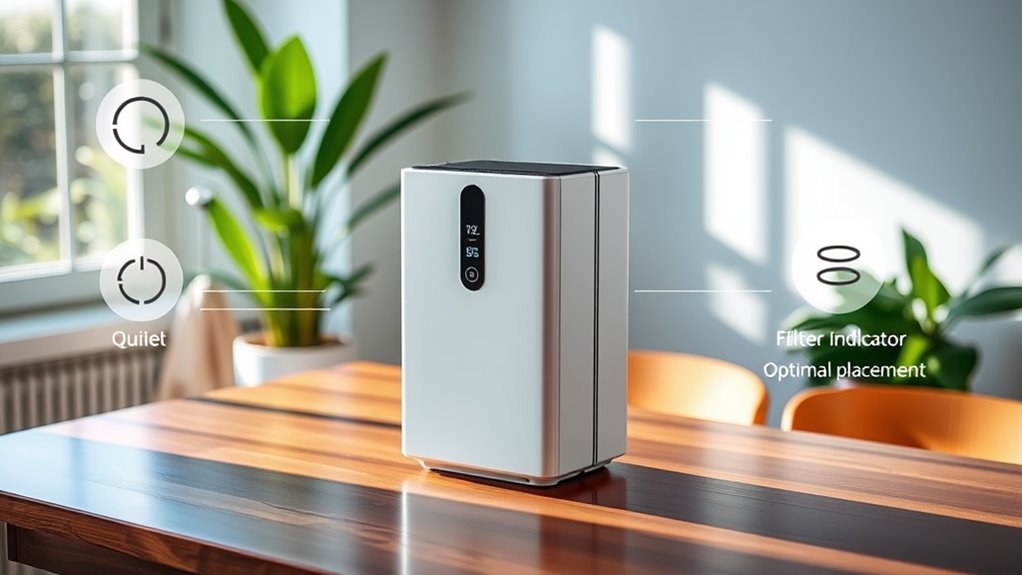
When choosing an air purifier, you’ll want to pay close attention to filter type, CADR performance ratings, and any smart features available.
A high-quality HEPA filter and a solid CADR rating can make a big difference in air quality.
Additionally, smart features can enhance your experience and help you maintain peak performance.
Filter Type Selection
As you explore air purifiers, understanding filter types is vital for effective air cleaning. Here are three key features to take into account during your filter type selection:
- HEPA Filters: Look for purifiers with HEPA filters, which capture 99.97% of particles sized 0.3 micrometers, helping eliminate common allergens like dust and pollen.
- Activated Carbon Filters: These are important for removing gases and odors. Remember, they need replacement every three months to maintain efficiency.
- Removable Pre-Filters: Choosing models with removable pre-filters can trap larger particles, extending the life of your main filters and boosting overall air cleaning performance.
Avoid ozone generators, as they can produce harmful ozone and may not effectively remove pollutants.
Prioritize models with high Clean Air Delivery Rate (CADR) scores for the best results.
CADR Performance Ratings
Understanding CADR (Clean Air Delivery Rate) performance ratings is essential for selecting an effective air purifier.
CADR scores indicate how well air purifiers remove specific pollutants, with ratings typically between 0 and 400 cfm for dust, pollen, and smoke.
For ideal air cleaning efficiency, aim for a minimum CADR of 150 cfm in small rooms (under 200 sq. ft.), 260 cfm for medium rooms (up to 400 sq. ft.), and over 300 cfm for larger spaces.
Remember, the effectiveness of an air purifier correlates more closely with its CADR rating than the type of filter used.
Always verify CADR ratings through trusted sources like the AHAM directory to confirm the purifier meets your room size and air quality needs.
Smart Features Availability
Smart features can greatly enhance your air purifier experience, making it easier to maintain a healthy indoor environment.
Here are three key smart features to look for:
- WiFi Connectivity: Monitor and control your air purifier remotely using a smartphone app, adding convenience to your daily routine.
- Air-Quality Sensors: These sensors automatically adjust the purifier’s cleaning speed based on detected pollution levels, optimizing efficiency.
- Filter Service Indicator: This handy feature notifies you when it’s time to replace or clean the filters, ensuring peak performance.
Additionally, consider models with voice control for hands-free operation and scheduling capabilities to set specific operating times.
With these smart features, you’ll enjoy a more effective and user-friendly air purification experience.
Optimal Placement for Maximum Efficiency

To guarantee your air purifier operates at peak efficiency, it’s crucial to place it correctly within your space. Aim for ideal placement by keeping 18 to 24 inches of open space around the unit to verify proper airflow.
Position the front of the air purifier toward the center of the room, allowing it to effectively circulate and filter the air. Place it on a hard, flat surface like wood or tile for stability, and consider using a thin mat on carpeted floors to enhance ventilation and prevent stains.
Avoid corners or behind furniture; this limits its ability to draw in airborne particles and maintain a clean environment. Always refer to the manufacturer’s manual for specific placement guidelines.
Maintenance Tips for Longevity
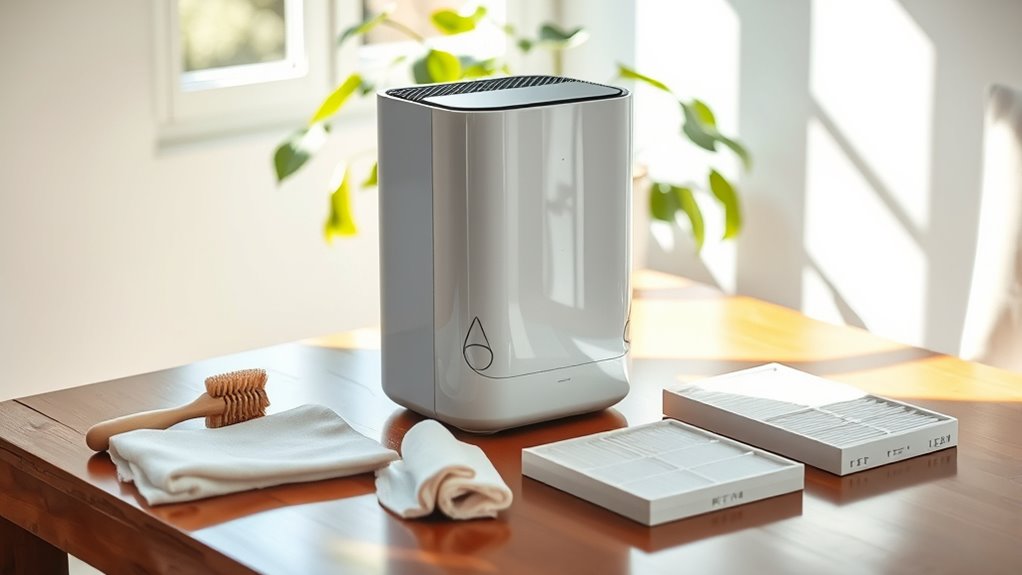
While you may enjoy the fresh air your purifier provides, keeping it well-maintained is essential for its longevity and performance.
Here are three key maintenance tips to follow:
- Regularly replace filters: Change mechanical filters every 6 to 12 months and activated carbon filters every 3 months for ideal air cleaning performance.
- Keep pre-filters clean: Vacuum or wash them as needed; a dirty pre-filter can reduce efficiency by up to 40%.
- Monitor service indicators: If your purifier has filter service indicator lights, pay attention to them for timely maintenance reminders.
Additionally, perform routine checks on your unit, clean the exterior, and store it in a dry, cool location to enhance its longevity and performance.
Comparing Brands and Models

When it comes to choosing the right air purifier, you’ll find a variety of brands and models, each offering unique features and price points.
The best air purifiers include Alen, known for customizable filters, and Blueair, recognized for energy efficiency and effective HEPA air cleaning.
Dyson stands out with innovative designs, while GermGuardian provides budget-friendly options with UV-C light technology.
Honeywell offers reliable choices without premium pricing.
If you’re concerned about respiratory issues, look for models with activated carbon filters to tackle odors and pollutants.
Additional Strategies for Improving Indoor Air Quality
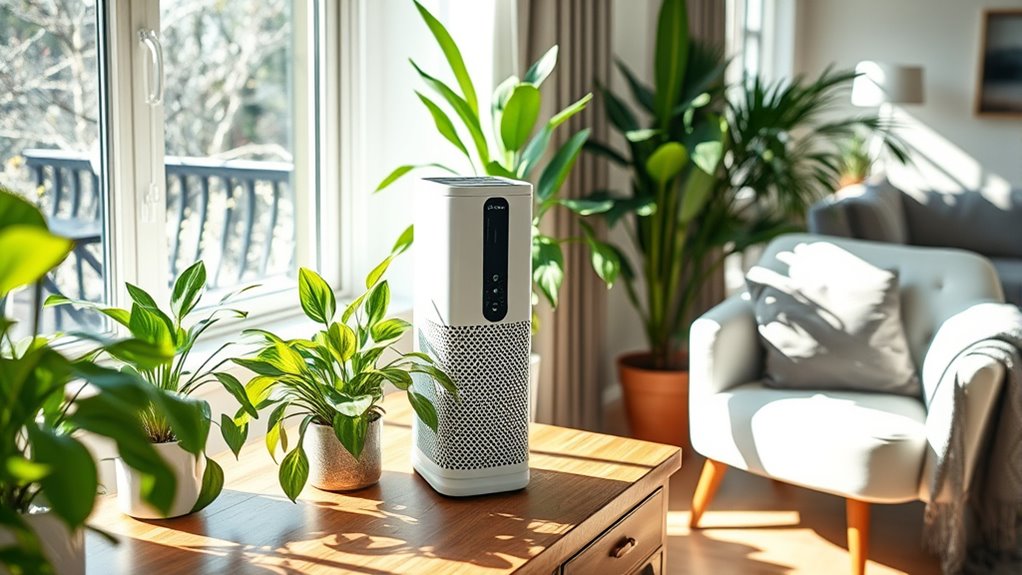
Improving indoor air quality goes beyond just using an air purifier; it involves a combination of practical strategies that can make a notable difference.
Enhancing indoor air quality requires a blend of strategies, not just reliance on air purifiers.
Consider these tips to enhance your home’s environment:
- Regularly vacuum with a HEPA-certified vacuum cleaner to minimize allergens like dust mites and pet hair.
- Use exhaust fans in kitchens and bathrooms to remove excess moisture and indoor pollutants.
- Incorporate houseplants, such as spider plants and peace lilies, known for their air-purifying qualities.
Additionally, open windows on pleasant days to let in fresh air and dilute contaminants.
Limit the use of chemical-heavy products and store hazardous materials away from living areas to reduce VOCs.
These steps, combined with air purifiers, can notably improve your indoor air quality.
Frequently Asked Questions
How Do I Choose the Best Air Purifier?
To choose the best air purifier, start by measuring your room’s square footage.
Make sure the CADR is at least two-thirds of that size for effective cleaning.
Opt for a HEPA filter to capture allergens and pollutants efficiently.
Pay attention to maintenance; select a model with easily replaceable filters.
Consider the noise level, especially if it’s for a bedroom.
Finally, look for features like air-quality sensors to enhance performance and convenience.
How to Judge a Good Air Purifier?
To judge a good air purifier, start by evaluating the Clean Air Delivery Rate (CADR); aim for at least 150 CFM for small rooms and over 300 CFM for larger spaces.
Check for HEPA filters that capture 99.97% of tiny particles.
Consider the unit’s size; larger purifiers often work more efficiently and quietly.
Finally, look for models with removable pre-filters and Energy Star certification to guarantee energy efficiency and extended filter life.
What to Look for While Buying an Air Purifier?
When you’re looking for an air purifier, don’t just focus on size; consider the CADR rating too.
A HEPA filter is essential for capturing allergens, but a removable pre-filter enhances efficiency.
While some models may be energy hogs, Energy Star certified ones save you money.
Also, noise levels matter—aim for around 50 decibels to keep your space peaceful.
Balancing these features guarantees you breathe cleaner air without compromising comfort or cost.
Where to Place an Air Purifier for Best Results?
To get the best results from your air purifier, place it in the center of the room with 18 to 24 inches of space around it.
Make sure the front faces the area where you spend the most time. Avoid putting it behind furniture or close to walls, as this blocks airflow.
For carpeted areas, use a thin mat underneath to prevent stains while keeping the unit on a hard, flat surface for stability.
Conclusion
In the quest for the perfect air purifier, you’re now armed with the knowledge to make an informed choice. By considering your air quality needs, understanding CADR ratings, and exploring key features, you’ll be well on your way to cleaner air. Remember, it’s not just about picking a device; it’s about creating a healthier environment for you and your family. So, take the leap and breathe easy—your lungs will thank you!
